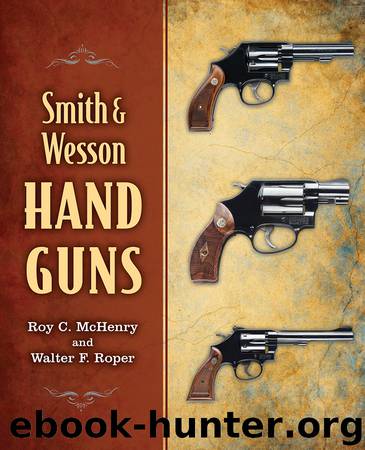Smith & Wesson Hand Guns by Roy C. McHenry

Author:Roy C. McHenry
Language: eng
Format: epub
Publisher: Skyhorse
Published: 2013-05-09T16:00:00+00:00
CHAPTER XVII.
COLT hand-ejector pocket revolvers in .32 caliber had been made for about IS years and Smith & Wesson side-swingers had been on the market for four years in larger caliber before the latter decided to adapt the system to a .32 pocket revolver. The design presented no special problem, as the gun would be simply a smaller model of the .38 Military and Police Model. But the ballistics department was requested to devise an improved cartridge before the new model was placed on the market, the old .32 S&W cartridge used in the jointed frame models being underpowered.
The new cartridge contained 13 grains of black powder and a 98-grain bullet with rounded end. It had the same diameter as the smaller cartridge so that it could be used interchangeably with it. Ballistically, it did not differ greatly from the Civil War rim fire .32 long, though the bullet was heavier by 8 grains. But in accuracy, the new ammunition was greatly superior and it is still rated high in the fifth column of those tables put out by cartridge manufacturers which show how far away a bullet is dependable with the proper aim and trigger pull. Its energy is only rated at 117 foot pounds, but a .32 is not suitable for big game hunting in any event.
Probably due to corresponding changes and improvements in the .38 Military & Police Model, the .32 Hand Ejector followed the same process of evolution. Most of these changes would be overlooked unless you took the action apart. Revolvers bearing serial numbers from 1 to 19,425 were made before any changes were made. Then, among other things, the cylinder stop notches were lengthened to fit an elongated stud slot, contributing to a better alignment of cylinder and barrel. In this form, it ran from 19,426 to 61,126, which gives some indication of its popularity. The second group of changes affected revolvers of this model running to 95,500 and all were of minor importance. As the parts catalogue puts it, however, “As there have been numerous changes in this arm it is advisable to send in the old part when ordering duplicates to avoid delay and chances of error.” A glance through the list of changes, all the way down through number six, will bring out all your compassion for the plant’s service department. The model had 50 parts, and each of them had to be kept in a special bin or compartment. Some were small enough to go through the eye of a fair-sized needle. Subsequent changes and serial brackets were as follows: Third change, 95,501-96,125; Fourth change, 96,126-102,500; Fifth change, 102,- 501-264,856; Sixth change, 264,857 ad infinitum, as they are still being made that way.
This category is a little hard to decipher, particularly in view of the fact that the Third Model hand-ejector, alias the .32 Regulation Police Model was announced in February, 1917. Presumably there was a Second Model, but the records covering it are incomplete. The Regulation Police Model was built with a square butt and appealed to shooters with large hands.
Download
This site does not store any files on its server. We only index and link to content provided by other sites. Please contact the content providers to delete copyright contents if any and email us, we'll remove relevant links or contents immediately.
Sapiens: A Brief History of Humankind by Yuval Noah Harari(13078)
The Tidewater Tales by John Barth(12039)
Do No Harm Stories of Life, Death and Brain Surgery by Henry Marsh(6343)
Mastermind: How to Think Like Sherlock Holmes by Maria Konnikova(6252)
The Thirst by Nesbo Jo(5795)
Why We Sleep: Unlocking the Power of Sleep and Dreams by Matthew Walker(5658)
Sapiens by Yuval Noah Harari(4553)
Life 3.0: Being Human in the Age of Artificial Intelligence by Tegmark Max(4521)
The Longevity Diet by Valter Longo(4454)
The Rules Do Not Apply by Ariel Levy(3915)
The Immortal Life of Henrietta Lacks by Rebecca Skloot(3833)
The Body: A Guide for Occupants by Bill Bryson(3817)
Why We Sleep by Matthew Walker(3782)
Animal Frequency by Melissa Alvarez(3762)
Yoga Anatomy by Kaminoff Leslie(3712)
Barron's AP Biology by Goldberg M.S. Deborah T(3636)
The Hacking of the American Mind by Robert H. Lustig(3588)
All Creatures Great and Small by James Herriot(3527)
Yoga Anatomy by Leslie Kaminoff & Amy Matthews(3405)
